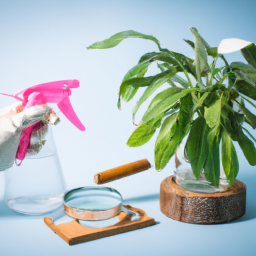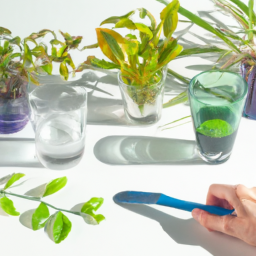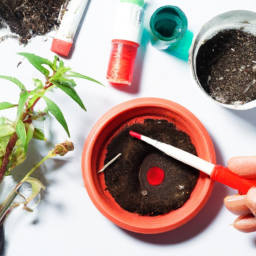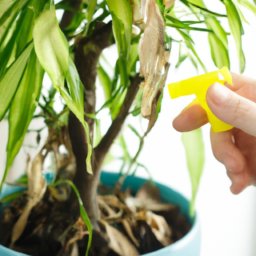
Have you ever found yourself in a panic after realizing that you’ve overwatered your beloved houseplants? Don’t worry, we’ve all been there! Overwatering is a common mistake that even the most experienced plant enthusiasts can make. But fear not, because in this blog post, we’ll be discussing the steps you can take to rescue your overwatered plants and bring them back to life. So, if you’re ready to learn how to save your precious green friends, keep reading for our expert tips on rescuing overwatered plants: steps to recovery.
Identifying Signs of Overwatering in Plants
Overwatering is a common mistake many plant enthusiasts make, often with the best intentions. However, excessive watering can lead to root rot, nutrient deficiencies, and ultimately, the demise of your beloved plants. In this guide, we will discuss how to identify signs of overwatering in plants and provide you with step-by-step instructions on how to rescue them.
1. Wilting and Yellowing Leaves
One of the first signs of overwatering in plants is wilting and yellowing leaves. When plants receive too much water, their roots become waterlogged, depriving them of oxygen. As a result, the leaves may appear droopy and start to turn yellow. It’s important to note that wilting and yellowing leaves can also be caused by other factors, such as nutrient deficiencies or pests. Therefore, it’s crucial to consider the overall health of the plant and look for additional signs of overwatering.
In addition to wilting and yellowing, overwatered plants may also exhibit soft and mushy leaves. If you notice a slimy texture when touching the leaves, it’s a clear indication of overwatering. This is a result of the plant cells breaking down due to excess moisture, leading to a loss of structural integrity.
To confirm if overwatering is the culprit, gently remove the plant from its pot and inspect the roots. Healthy roots should be firm and white, while overwatered roots will appear brown, mushy, and may emit a foul odor.
2. Mold and Fungus Growth
Another sign of overwatering in plants is the growth of mold and fungus. Excess moisture creates a favorable environment for fungal spores to thrive, leading to the development of mold on the soil surface or even on the plant itself. If you notice a fuzzy or powdery substance on the leaves, stems, or soil, it’s a clear indication of overwatering.
Mold and fungus not only affect the aesthetic appeal of your plants but can also hinder their ability to absorb nutrients and water. This can further exacerbate the overwatering issue and lead to more severe damage if not addressed promptly.
To prevent mold and fungus growth, ensure proper airflow around your plants by spacing them appropriately and avoiding overcrowding. Additionally, consider using well-draining soil and adjusting your watering routine to avoid excessive moisture accumulation.
3. Stunted Growth and Root Rot
Overwatering can also cause stunted growth and root rot in plants. When roots are constantly submerged in water, they are deprived of oxygen, which is essential for their proper functioning. As a result, the roots may start to decay, leading to root rot.
Plants suffering from root rot often exhibit stunted growth, as the damaged roots are unable to efficiently absorb nutrients and water from the soil. You may notice that your plant is not growing as vigorously as it should or that new leaves are smaller and pale in color.
To check for root rot, carefully remove the plant from its pot and examine the roots. Healthy roots should be firm and white, while rotting roots will appear brown, slimy, and emit a foul odor. If you identify root rot, it’s crucial to take immediate action to save your plant.
Now that you are familiar with the signs of overwatering in plants, it’s time to move on to the next step: rescuing your overwatered plants. Stay tuned for our comprehensive guide on how to revive and restore your waterlogged plants to their former glory!

Rescuing Overwatered Plants: Steps to Recovery
Introduction
Overwatering is a common mistake that many plant owners make, often with good intentions. However, excessive watering can lead to root rot and other issues that can harm the health of your beloved plants. If you find yourself in a situation where you have overwatered your plants, don’t panic! With the right steps and a little patience, you can help your plants recover and thrive once again.
Step 1: Assess the Damage
Before taking any action, it’s important to assess the extent of the damage caused by overwatering. Signs of overwatering include yellowing leaves, wilting, and a sour or musty odor emanating from the soil. Carefully examine the plant’s roots and look for any signs of rot or mushiness. This will help you determine the severity of the overwatering and guide your recovery efforts.
If the roots are healthy and firm, you may have caught the overwatering early, which increases the chances of successful recovery. However, if the roots are mushy or discolored, the overwatering may have caused irreversible damage, and it might be challenging to save the plant.
Regardless of the damage, it’s worth giving your plant a chance to recover by following the subsequent steps.
Step 2: Adjust Watering Schedule
One of the most crucial steps in rescuing overwatered plants is to adjust your watering schedule. Allow the soil to dry out completely before watering again. This will help prevent further damage and allow the roots to recover. Check the moisture level of the soil by inserting your finger about an inch deep into the soil. If it feels moist, hold off on watering until it dries out.
When you do water, ensure that you provide enough water to thoroughly saturate the soil, but avoid letting the plant sit in standing water. Proper drainage is essential for preventing overwatering in the future.
Remember, different plants have different water requirements, so it’s essential to research the specific needs of your plant to establish an appropriate watering schedule.
Step 3: Improve Drainage
To prevent overwatering in the future and aid in the recovery process, it’s crucial to improve the drainage of your plant’s pot or planting area. Ensure that the container or pot has drainage holes at the bottom to allow excess water to escape. If your plant is in the ground, consider amending the soil with organic matter, such as compost, to improve its drainage capabilities.
Additionally, you can elevate the pot by placing it on top of a tray filled with pebbles or small rocks. This will create a gap between the pot and the water collected in the tray, preventing the roots from sitting in standing water.
By improving drainage, you can help prevent future overwatering incidents and create a healthier environment for your plants to thrive.
Step 4: Trim and Prune
Overwatering can cause damage to the leaves and stems of your plants. To promote recovery and encourage new growth, it’s important to trim and prune any affected areas. Use clean and sharp pruning shears to remove yellowing or wilting leaves, as well as any soft or mushy stems.
Trimming and pruning will not only improve the appearance of your plant but also redirect the plant’s energy towards healthy growth. Be sure to dispose of the trimmed foliage properly to prevent the spread of any potential diseases.
After pruning, monitor your plant closely for any signs of new growth. This is a positive indication that your plant is on the road to recovery.
Step 5: Provide Proper Nutrients
Overwatering can wash away essential nutrients from the soil, depriving your plants of the nourishment they need. To aid in their recovery, it’s important to provide proper nutrients. Consider using a balanced fertilizer specifically formulated for your plant’s needs.
Follow the manufacturer’s instructions for application and avoid overfertilizing, as this can cause further stress to your plants. Slow-release fertilizers are often a good option as they provide a steady supply of nutrients over time.
Remember to regularly monitor your plant’s progress and adjust the fertilization accordingly. Healthy plants are more resilient to overwatering and other environmental stressors.
Conclusion
Rescuing overwatered plants requires patience, care, and a willingness to make necessary adjustments. By assessing the damage, adjusting your watering schedule, improving drainage, trimming and pruning, and providing proper nutrients, you can help your plants recover from the effects of overwatering.
Remember, prevention is always better than cure, so it’s important to understand the specific watering needs of your plants and provide them with the appropriate care. With a little knowledge and attention, you can ensure the long-term health and vitality of your beloved green companions.

Rescuing Overwatered Plants: Steps to Recovery
Overwatering is a common mistake that many plant enthusiasts make, often with good intentions. However, excessive water can lead to root rot, nutrient deficiencies, and even the death of your beloved plants. If you’ve accidentally overwatered your plants, don’t panic! With a few simple steps, you can help them recover and thrive once again.
Assess the Damage
The first step in rescuing overwatered plants is to assess the extent of the damage. Look for signs of overwatering such as yellowing leaves, wilting, or a foul odor coming from the soil. Carefully remove the plant from its pot and inspect the roots. Healthy roots should be firm and white, while overwatered roots may appear mushy, brown, or even black.
If the damage is minimal and limited to the roots, there’s a good chance that your plant can recover. However, if the roots are severely damaged or rotten, it may be more difficult to save the plant. In such cases, you may need to consider propagating healthy parts of the plant to start anew.
Once you’ve assessed the damage, it’s time to take action to help your overwatered plant bounce back.
1. Adjust the Watering Schedule
One of the most important steps in rescuing overwatered plants is to adjust your watering schedule. It’s crucial to give the roots a chance to dry out and recover. Depending on the severity of the overwatering, you may need to stop watering the plant altogether for a few days or even weeks.
Check the moisture level of the soil by sticking your finger about an inch into the soil. If it feels damp, hold off on watering. Once the top inch of the soil feels dry, it’s a sign that the roots have started to recover and you can resume watering, but do so sparingly. Remember, it’s better to underwater than to overwater.
2. Improve Drainage
Another crucial step in rescuing overwatered plants is to improve the drainage of the soil. Excess water should be able to flow freely through the soil and drain out of the pot. If your plant is in a pot without drainage holes, consider repotting it into a container with proper drainage.
You can also add materials like perlite or coarse sand to the soil mix to improve drainage. These materials help create air pockets in the soil, preventing it from becoming waterlogged. Additionally, ensure that the pot you choose is the right size for your plant – a pot that is too large can hold excess water, leading to overwatering.
3. Trim and Prune
Overwatered plants often experience leaf yellowing and wilting due to nutrient deficiencies and root damage. To help your plant recover, it’s important to trim and prune any dead or yellowed leaves. This will redirect the plant’s energy towards new growth and allow it to focus on healing the roots.
Use clean and sharp pruning shears to make clean cuts, ensuring you don’t damage any healthy parts of the plant. If you notice any mushy or rotten roots during the pruning process, carefully remove them to prevent further decay.
Tips for Preventing Overwatering in the Future
Now that you’ve successfully rescued your overwatered plants, it’s important to implement preventive measures to avoid making the same mistake again. Here are some tips to help you prevent overwatering in the future:
1. Understand Your Plant’s Watering Needs
Each plant has different watering requirements. Take the time to research and understand the specific needs of your plants. Factors such as the plant’s natural habitat, growth stage, and soil type can all affect its watering needs. By knowing your plant’s requirements, you can avoid overwatering or underwatering.
2. Use the Right Soil Mix
Choosing the right soil mix is crucial for maintaining proper drainage. Opt for a well-draining potting mix that allows excess water to flow through easily. Avoid heavy soils that retain water for extended periods, as they can increase the risk of overwatering.
3. Establish a Watering Routine
Establishing a consistent watering routine can help prevent overwatering. Create a schedule based on your plant’s needs and stick to it. Consider using a moisture meter or your finger to check the soil’s moisture level before watering. Remember, it’s better to underwater than to overwater.
By following these tips, you can ensure the health and longevity of your plants while avoiding the pitfalls of overwatering.
Let’s wrap up what we learned
Overwatering plants is a common mistake that many gardeners make, and it can lead to some serious consequences for our green friends. But fear not! There are steps you can take to rescue your overwatered plants and nurse them back to health. So, if you’ve accidentally drowned your beloved plant, here’s what you can do to help it recover.
First things first, you need to assess the damage. Overwatering can cause root rot, which is a serious condition that affects the plant’s ability to absorb nutrients and water. Check if the soil is waterlogged and if the roots are mushy or discolored. If so, it’s time to take action. Start by gently removing the plant from its pot and inspecting the roots. Trim away any rotten or damaged roots using clean, sharp scissors. Then, allow the plant to dry out by placing it in a well-ventilated area with indirect sunlight. This will help prevent further root rot and give the plant a chance to recover. Once the soil is dry, repot the plant in fresh, well-draining soil and water it sparingly, only when the top inch of soil feels dry to the touch. With some patience and care, your overwatered plant will have a fighting chance to bounce back and thrive once again.
Your Questions Answered. Comprehensive FAQ:
Q1: How can I tell if my plant has been overwatered?
A1: Overwatering can cause several visible signs in plants. Look for yellowing or wilting leaves, mushy or rotten roots, and a foul smell coming from the soil. If the soil feels constantly wet or waterlogged, it’s a clear indication of overwatering.
Q2: What should I do if I’ve overwatered my plant?
A2: If you’ve overwatered your plant, the first step is to remove it from its pot and gently shake off any excess water. Then, carefully inspect the roots for signs of rot or damage. Trim off any mushy or brown roots and allow the plant to dry out in a well-ventilated area for a few days.
Q3: How often should I water an overwatered plant?
A3: After rescuing an overwatered plant, it’s crucial to adjust your watering routine. Let the plant fully dry out before watering it again. The frequency will depend on various factors such as plant type, size, and environmental conditions. Always check the moisture level of the soil before watering to avoid overwatering in the future.
Q4: Can I save an overwatered plant with yellow leaves?
A4: Yes, there is still hope for an overwatered plant with yellow leaves. Start by addressing the overwatering issue and follow the steps mentioned earlier. Once the plant has dried out and you’ve adjusted your watering habits, new healthy growth should emerge. However, if the yellow leaves are severely damaged or have turned brown, it’s best to remove them to allow the plant to focus its energy on regrowth.
Q5: Are there any additional tips to help an overwatered plant recover?
A5: Absolutely! Along with adjusting your watering routine, you can assist the recovery process by providing proper drainage for your plant’s pot, ensuring it is placed in a well-lit area but away from direct sunlight, and avoiding the use of fertilizer until the plant has fully recovered. Additionally, consider using a moisture meter to accurately monitor the soil’s moisture level and prevent overwatering in the future.

Lisa Chen is a seasoned indoor gardening expert and the author of several bestselling books on the topic. With a background in horticulture and urban farming, Lisa is dedicated to helping urban dwellers embrace the joys of cultivating green spaces indoors. Her detailed guides and hands-on tips empower readers to transform their living spaces into thriving plant sanctuaries.


